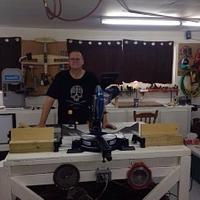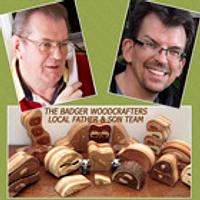
MsDebbieP
in almost 12 years
TIPS ... for precision cutting
11 Replies
Accuracy is my nemesis. I measure like a mad man, I measure the wood, I measure the distance between blade and fence, I measure the temperature and the mood of my cat. I measure and measure and measure. Still it never comes out where I think it should.
I know how it’s done by the greats…you cut just inside or outside that line then trim it with a chisel or a block plane or a Lee Valley mortice maginificenter. Still first shot is too wide…trim, scrape, flatten…too small!
-- Alec (Friends call me Wolf, no idea why)
Precision cutting require you fine tune your tools first. Be it hand tools or electric tools, if they are not cutting correctly your are not going to cut precisely.
Every couple of months I clean my tools, clean the saw blades, router bit I used.
Check to make sure the table saw fence is square to the table top and parallel to the miter slot
I make sure the drum sander drum is still parallel to the bed etc…
Every time I get in the shop, the first thing I do before using my table saw is to check for square.
One thing that is most often overlooked is the "squareness " of our square. Most of them are actually out of square. I went through 4 square before finding one that is square along the entire 6" length. Most of them are square the first couple of inches.
Yes I am lucky my woodworking teacher is also a machinist. He helped me check the squares.
The other think that comes to mind is preparing the stock adequately before cutting.
Do I follow that all the time? No. Many times I rush and it shows:)
Abbas, Castro Valley, CA
I don’t know about anyone else but I measure twice knife once mark once and cut twice. Let me explain. First I take off the glasses and close the weaker eye then measure and write it down. Then walk around the bench or project to make sure I’m not missing something. Then measure again and compare to my noted first measure. Next I cut the mark into the wood with my marking knife, closing the weak eye again, making sure to go all he way around, even if it’s just a table saw cut. Then I mark in the cut groove with my pencil. And add an “X” to show the waste. Lastly I cut twice, my first cut is about two saw blade thickness away, just to eliminate blade flex. Keeping tool blades sharp and clean in critical to a smooth cut. Most people don’t spend the time the way I do but I rarely waste by making a wrong cut.
CHRIS, Charlottetown PEI Canada. Anytime you can repurpose, reuse, or recycle, everyone wins!
I try not to measure (in numbers) any more than I absolutely have to. Whenever possible, and it usually is, I use one piece to set up the tool for the other piece. Hard to explain but it’s how I learned in shipyards years ago. “Measure from the work”, “story stick” …. there are as many names as techniques but the bottom line is why introduce another source of error? In the simplest case, if you have a board and want to cut another the same width, don’t measure it. Put it in the saw and set the saw to its edge. Then cut your second piece.
This isn’t really about precision cutting, it’s more a way of going about woodworking in general I guess.
The early bird gets the worm but its the second mouse that gets the cheese.
I found this :http://www.leevalley.com/US/newsletters/Woodworking/1/5/article1.htm one day. It’s short and I found it helpful.
-- Alec (Friends call me Wolf, no idea why)
We sometimes get over obsessed with accuracy. I was watching Roy Underhill’s show some time back and his guest was Chris Schwartz (of PWW fame) who announced that “measuring is the enemy of accuracy”. Even so, nothing strikes more fear in my heart than the phrase" cut close to the line, and then “sand, chisel, plane, whatever” to it. All that said, I don’t do anything more special than use several of the tips above and my cuts are within a 1/32" or less…..seldom a problem with wood.
"I long for the day when coke was a cola and a joint was a bad place to be" Merle Haggartd
I work a lot like Paul described above. I don’t worry to much about precise measurements and for duplicate parts it is just to shove it through machine set-ups and/or use actual parts to set the machines up for duplicates. This mostly involves fixed fence locations for widths, stops for lengths and angled set-up blanks for reproducing angles. A good example of this type thinking is my Christmas basket project. The sides on my plan call for 15 deg. but they can be any angle. The only important thing is that all four sides are the same angle. An angled auxiliary fence used to cut the sides insures that the angles will be identical.
Mike, an American living in Norway
I’m with Paul and Mike…I’ve found if I focus on the measurement too much, I always end up off. I measure to make my initial marks and set my stop, fence, whatever, then cut. From there, I use the cut piece to mark the joining piece. If I have to make a duplicate of a part after the initial setup, I use the other piece to re-set my stops / fence. It’s not so much being precise as it is being consistent. If you make one component precisely to the plans, but every other part is a 16th off, it ends up looking like the precise part is mis-cut.
For bandsaws, follow this video https://www.youtube.com/watch?v=wGbZqWac0jU
Love to keep busy in retirement - http://www.getwoodworking.com/albums/member_album.asp?a=33974
Thanks M&M.
I have not seen this one from Ales before.
Abbas, Castro Valley, CA
I saw quite a few before seeing the Carter one, but it is really good. I’m still thinking setriously about the Carter Stabilizer with the shipping and tax, it bumps the price up to over double.
Love to keep busy in retirement - http://www.getwoodworking.com/albums/member_album.asp?a=33974
















